
Editor’s Note: Salima Ikram is a professor of Egyptology at the American University in Cairo. She is the co-director of the Animal Mummy Project at the Egyptian Museum and since 2001 she has directed the North Kharga Oasis Survey (NKOS) with Corinna Rossi, and directed the North Kharga Oasis Darb Ain Amur Survey and the Amenmesse Mission of KV10 and KV63 in the Valley of the Kings. She co-directed the Predynastic Gallery Project. Ikram has been very active and sought out by the media for her expertise, contributing to articles on Egyptology in Egypt Today and National Geographic, writing for Kmt, a journal of modern Egyptology, and appearing in documentary series and specials for PBS, Channel 4, Discovery Channel, History Channel, National Geographic Channel, Netflix, and the BBC.
_________________________________
RM (Richard Marranca): I just viewed the documentary, Secrets of the Dead: Egypt’s Darkest Hour. It was so interesting and macabre – this mass grave of mummies and body parts strewn about from the collapse of the Old Kingdom. Can you describe that history and carnage?
SI (Salima Ikram): The end of the Old Kingdom was brought about by a variety of factors. The most significant was of course climate change, where a series of Low Niles and an increasing desertification caused famine, and therefore civil unrest. In addition to that, King Pepi II had an extraordinarily long reign, during which time a lot of power slipped out of his hand and into the provincial nobility. He also allowed the Royal women to marry provincial elites, which gave those people even greater power legitimacy. In order to make sure that the priesthood supported him, he allowed temples not to pay taxes to him and this series of exemption decrees also decreased royal power and general control. In general, what happened was that a lot of the provincial elites started to flex their muscles and challenge central authority, particularly upon the death of the King. Egypt fell into a group of warring city states, with the nobles having their own armies, and probably also bringing in mercenaries, both from the south and north East. It is these battles that are in part responsible for mass graves. Of course, what you saw on television is really also a result of secondary looters in modern times.
RM: What does the word mummy mean, and what is a mummy?
SI: The word mummy comes from the Arabic word mum or mumia, which basically means wax or a black bitumenous substance originating from the mummy mountain in Persia. A mummy is an artificially preserved body of a human or an animal.
RM: Can you mention the highlights in the process of mummification in ancient Egypt?
SI: Mummification changed a great deal over the 3000 years of Egyptian history in which it was practiced. Some of the key components were: learning to eviscerate and desiccate using natron; and also the judicious use of resins and oils, giving the body a more lifelike appearance.
RM: What are some of the greatest ancient writings and images of mummification?
SI: One of the reasons people think of mummification as mysterious is that the ancient Egyptians did not leave a recipe book or manual telling us how to carry out mummification. There are very few images showing mummies being made, and these all date from the later periods of Egyptian history and mainly show the wrapping of the body. Textual evidence is also limited to receipts from embalmers and a text mentioning the wrapping of an Apis bull. Thus, information comes from the mummies themselves and to a large extent, from classical writers such as Herodotus and Diodorus Siculus.
RM: Can you tell us about the Egyptian tomb and its purpose? What are some types?
SI:
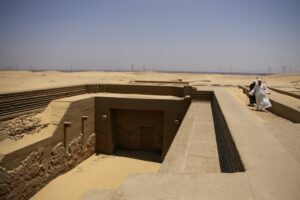
The tomb of Den, the 4th king of Egypt’s 1st Dynasty, at Abydos. E M, Creative Commons Attribution 2.0 Generic, Wikimedia Commons
There are many different types of Egyptian tombs, varying depending on the date and whether they were for a king or for a commoner. However, tombs basically had the same function, regardless of who owned them. A tomb acts as a machine coma if you will – a coma that transports the deceased from this world to the next. A tomb also is a parallel cosmos in and of itself, of an eternal Egypt. The tomb is divided into two sections; one is the public area where people celebrate the cult of the deceased, and the other is underground where the body is buried. This is sealed up and after the funeral is not supposed to be accessible, unless you have a group tomb in which case more and more bodies will be placed there. The upper part of the tomb, which is what people visit even today, is where there are scenes of daily life as well as religious, which are the cosmos of eternity that the deceased will enjoy.
RM: Are there curses in the tombs?
SI: The idea of curses is actually a false one. Tutankhamen’s tomb had no curse inscribed in it. That was made up by journalists. There are some tombs though that do have curses and they basically say that if anyone comes in to violate the tomb, or is impure, then may they be strangled like a goose and may the gods sit in judgement of the violator. A few of them do have more colorful variations on this theme, saying may the snake, may the crocodile, may the lion destroy you.
RM: Can you tell us about the relationship between Egyptian religion and mummification? Also, what is the Book of the Dead?
SI: The Book of the Dead is more properly called the book of coming forth by day and consists of a series of spells that help the deceased go from this world to the next. It is a bit like a crib sheet. As the Egyptians believed that you lived forever they felt that the aspects of your soul needed to have a body to animate, which is why mummification was born, so that the soul could live in a proper body. Of course images, both 2 and 3 dimensional, were also available for the soul to animate. The soul had a variety of components: the ka — one’s doppleganger; the ba — a human-headed bird that was the part of your soul that could fly here — the closest we get to a ghost; and the akh, which is the divine spark that can go off and be eternally joined with the stars.
______________________________
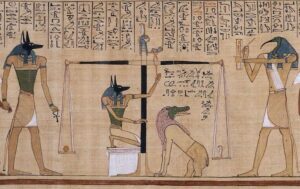
Above and below: Vignettes from the Book of the Dead of Hunefer. Public Domain, Wikimedia Commons
______________________________

______________________________
RM: My students love the Isis & Osiris story. Why is this so important, so foundational?
SI: The Story of Isis and Osiris is so compelling because it is a love story as well as a promise of eternal life and resurrection. It has all the components for a good tale of swashbuckling, good vs evil, drama, romance, with the good guys winning in the end. For the ancient Egyptians this established and explained the role of divine kingship as well as the idea of eternal life and with us key to both state religion as well as personal piety in terms of funerary beliefs. What did ancient authorities do when they realized it wasn’t safe to keep mummies in their tombs – that is, to bring them into more secure hiding spots? Seems cloak and dagger. Moving mummies was something that really seemed to happen most in the Third Intermediate, although it is quite possible that violated tombs were reconsecrated and bones gathered together and reburied in earlier periods as well. Of course, in times of political turmoil when raiders, whether Egyptian or from abroad, were terrorizing the countryside, burials had to be protected and this is why bodies were moved about and put into caches for safe keeping.
_____________________________

The family of Osiris. Osiris on a lapis lazuli pillar in the middle, flanked by Horus on the left and Isis on the right (22nd dynasty, Louvre, Paris). Rama, Creative Commons Attribution-Share Alike 2.0 France, Wikimedia Commons
_____________________________
Advertisement
_____________________________
RM: Who were some of the colorful early figures early in the search for mummies?
SI: A lot of doctors had agents who would go out and collect mummies because in Europe mummies were ground up and eaten as medicine because of the mistaken belief that they were made using this bituminous substance. An enjoyable explorer who also worked with mummies was Belzoni, who collected several mummies and sent them off to Europe for collectors; one of his friends, Thomas Pettigrew — also known as Mummy Pettigrew — staged some of the earliest scientific unwrapping and studies of mummies.
RM: About when and with whom did Egyptology become scientific?
SI: One can say that the start of proper Egyptology is after 1822 with the decipherment of hieroglyphs and slowly the Egyptians could speak to us in their own voices and there was less speculation about how they lived and what they did. Of course, Egyptology is continuing to become increasingly scientific as more and more technologies become available to us. The majority of the early mummy and skeletal studies used basic tools to extract limited information from mummies.
The most simple and common method, sometimes the sole one used when in the field, is visual examination. Such examinations yield crucial information about the bandage patterns, amulets and other objects placed on the mummy, body and arm positions, cosmetics, tattooing, and hairstyles. Although the unwrappings and resulting autopsies are destructive, they still provide invaluable detailed and useful information. Several scientific autopsies were carried out on mummies during the 1970s, with multidisciplinary teams of researchers involved in the investigations (Cockburn et al. 1975; Hart et al. 1977; David 1979; Cockburn et al. 1980: 52–70; Millet et al. 1980; Reyman and Peck 1980; David and Tapp 1984; Goyon and Josset 1988). Diseases can also be tentatively identified with the naked eye, although such identifications are unreliable. For example, visual examination identified a possible case of poliomyelitis in the mummy of the Pharaoh Siptah (Smith 1912: 70–73). Polio is a viral infection of the central nervous system that manifests itself in the paralysis of one or more muscle groups: Siptah has one short and withered leg. On the other hand, the same symptoms can result from certain types of cerebral palsy. Smallpox has also been suspected in the mummy of the pharaoh Ramesses V, due to the pox markings visible on his face (Smith 1912: 90–92). Visual examination can be augmented by scientific analyses that can provide information about other aspects of mummification, such as identification of the materials used in mummification, or a study of mummified tissues. As the sciences evolved, so did mummy studies.
The first mummy to be submitted to a professional chemical analysis (in an effort to determine the materials used in its manufacture) was the ‘Leeds Mummy’ (George 1828); although the results of this examination raised more questions than answers, it was the first such scientific investigation carried out on a mummy, setting the foundation for further studies, particularly those performed by Alfred Lucas in the early twentieth century. Lucas collaborated extensively with Egyptologists and physical anthropologists on identifying the different materials used in mummification (Lucas 1910, 1931, 1932, 1962).
The first microscopic examination of ancient Egyptian tissue was performed by the Viennese laryngologist, Johan Czermak (1852). This sort of study increased dramatically in the twentieth century with the advent of ‘palaeopathology’—a term coined by Marc Armand Ruffer (1921), Professor of Bacteriology in Cairo, meaning the study of ancient diseases from the tissues. One of this field’s major aims is to trace the origins, development, and disappearance of specific diseases and to study the effects of diseases on society (Brothwell et al. 1967). Ruffer used microscopic examination on many samples from mummies and managed to identify diseases as well as organs that had dried beyond recognition (Ruffer 1921, 1911; Moodie 1931). Nowadays of course we have X-rays and very good CT scans that allow for much more nuanced imaging. Of course, it is always helpful to have the data from the earlier studies as it helps us to interpret things that might not be immediately clear or apparent on the CT scan. Imaging methods allow us to study mummies nondestructively, which is a great boon.
______________________________
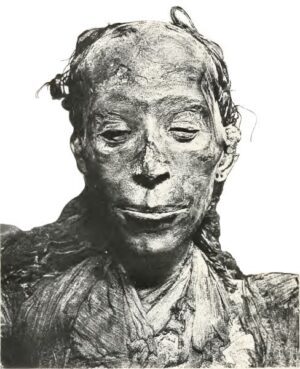
The mummy of the ancient Egyptian noblewoman Tjuyu. Quibell, J. E.; Smith, Grafton Elliot (1908). Tomb of Yuaa and Thuiu. Le Caire Impremerie De L’Institut Francais D’Archeologie Orientale Plate LIX, E. Brugsch, Public Domain, Wikimedia Commons
______________________________

Mummy of Ahmose, at Luxor Museum in Luxor Egypt. Tim Adams, Creative Commons Attribution 3.0 Unported, Wikimedia Commons
______________________________
RM: Beginning in ancient times, the theft and abuse of mummies has been rampant. Can you tell us about them being used for fuel and medicine, for amusement and parties?
SI: In addition to eating them for medicine (see above): Once the mummies got to Europe they provided people with further ghoulish entertainment: unwrappings. These became social events and were very much a part of Victorian parlour entertainment, with special invitations being sent out for them. Mummy unwrappings did not start in the nineteenth century; many other curious individuals had staged unwrapping shows in previous years. One of the earliest recorded unwrappings occurred in September 1698, when Benoit de Maillet (1656-1738), Louis XIV’s consul in Cairo, unwrapped a mummy before a group of French travelers. Unfortunately he, as with most of his successors in unwrapping, did not record anything concerning the mummy; they only mention some of the amulets found on it. Mummies were so abundant that despite the mania for collection and unwrapping, there still remained sufficient mummies in Egypt for what might be termed, ‘useful purposes’. A special paint, called Mummy Brown, was derived from fragments of mummified bodies and used in oil painting. One singularly pious artist was so upset to find that actual bodies of humans had been used to manufacture his paint, that he took all his tubes of Mummy Brown into the garden and gave them a decent burial.
In the nineteenth century, an American paper manufacturer from Maine, Augustus Stanwood, used linen mummy wrapping to make brown paper. This paper was sold to butchers and grocers who wrapped meat, butter, and the like in it—once people found out the source, this stopped being common practice. Cat mummies were shipped from Egypt to Europe for a twofold purpose: first, they helped provide a bit of ballast for the boats; second, they were used as fertilizer until public outcry put a stop to it. Mummies suffered many ignominies in Egypt. They were burnt as firewood since wood was scarce and mummies plentiful. Their arms and legs were used as torches when people wished to explore sepulchers or see their way at night. Mark Twain reports (one suspects with his tongue firmly in his cheek) that they were even reported as being used as fuel to fire locomotives.
RM: Can you tell us about the tomb-raiding Abd el-Rassul family’s amazing discovery and the plot to sell stuff?
SI: Perhaps the most spectacular of all mummy finds occurred in the early 1870s, although not revealed to the world until the beginning of the next decade. In 1871, according to one of the many versions of the story, Ahmed Abd el-Rassul of Qurna (d.1918/19) went in search of a lost goat near Deir el-Bahari and found that it had fallen into a tomb-shaft. Descending, he discovered some antiquities lying half-covered with sand at the bottom. As he scraped away the sand from his new-found treasures, he came upon the outline of an opening that had been hidden by the sand and rock debris in the shaft. The opening proved to be a sealed doorway. With growing excitement, he chipped a small hole through it and peered into the darkness where he saw coffins: dozens of them. He found the tomb of Pinudjem II (Dynasty 21; tomb DB320), which not only contained several members of the priest’s family, but also sheltered the coffins and mummies of over 30 individuals who had been placed there for their protection in antiquity.
For the next 10 years he, his brother Mohammed (d. 1926), and a few other members of his family steadily removed smaller objects from the cache and sold them, piece by piece, to antiquities dealers in Luxor, notably Mustapha Agha Ayat (d.1887), who traded extensively abroad — typical examples were papyri and canopic jars from Pinudjem’s family. This flood of antiquities, which were especially noticeable as some bore royal cartouches, came to the attention of Gaston Maspero (1846-1916), the Director General of the Antiquities Service. He ordered an investigation, and on 4 April 1881 the Abd el-Rassul brothers were arrested. Both pleaded their innocence and were released due to insufficient evidence. After their temporary incarceration, the brothers had a falling out over the apportioning of the profits from the illicit sales of antiquities. The quarrel became exceptionally heated, and the secret of the tomb’s existence became public. The upshot of all this was that Mohammed Abd el-Rassul, after obtaining some guarantees from officialdom, decided to make a full confession to the Governor of Qena Province. On 6 July 1881, he took the Antiquities officials, Emile Brugsch (1842-1930) and Ahmed Kamal (1851-1923), along with their colleagues and policemen to the tomb.
The tomb, reached by a 12 m shaft, extended for many meters into the mountainside. Its first corridor was stuffed full with coffins, shabti boxes, canopic jars, and metal libation vessels; at its end lay a leather tent belonging to Isetemkheb D, one of the original inhabitants of the tomb. The second corridor, at right angles to the first, contained many more coffins, with a large stack of these in a chamber to one side. Beyond this side chamber a long empty corridor led to the burial chamber of Pinudjem II and his family. In all, the tomb contained mummies, statues, jars, shrines, and other objects from the burials of 54 individuals, many royal, and all mainly dating from the New Kingdom. The bodies of Amenhotep I, Tuthmosis II, Seti I, Ramesses II, Merneptah, and Ramesses III, among others were recovered from this most dramatic and large royal cache. 300 workmen were hired to remove the contents of the cache and the 40 mummies and their paraphernalia, loaded onto a steamboat for their passage to Cairo. As the boat passed the villages along the banks of the Nile the villagers would come out, lining the way of the steamboat, and wail, ululate, and fire guns in tribute to the dead monarchs. The atmosphere of these events is recaptured by the greatest of all Egyptology-inspired movies: Shadi Addelsalam’s “Night of the Counting of the Years,” made in 1966. The family finally went to work with the Antiquities Service but did not give up entirely on its nefarious ways—they possibly helped steal from the tomb of Amenhotep II, but were also part of Carter’s workers, with a young Abd el Rasul being the famous model for the Tutankhamun necklace. Now they run hotels and cafes on the west bank.
RM: Soon after X-rays were discovered, archaeologists began X-raying mummies. Could you tell us about the powerful tools in the study of mummies, such as X-rays and CT scanning? Also, in your book, The Mummy in Ancient Egypt: Equipping the Dead for Eternity (co-written with Aidan Dodson), you mention many superb and damaged mummies. Can you tell us about a few of these?
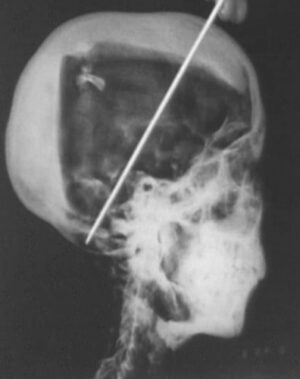
Tutankhamun skull x-ray. Public Domain, Wikimedia Commons
SI: Poor King Taa the 2nd has so many wounds on his head and his hands are all tensed and cramped suggesting that he died and was mummified in a way when they could not straighten out his fingers. He has wounds from battles that might have started to heal but again maybe he was healing but assassins came and devastated him. The mummy of Ramses III is really interesting because CT scans have been carried out and it seems that there is a cut on his neck and he might have been or, in fact, he probably was assassinated. This is very interesting because there is actually a court case recorded about an attempted assassination of that king. Of course Ramses II has lots of great stories associated with him because he’s the only pharaoh to have a passport from the modern Egyptian state. He was greeted by the French president and afforded all the honors of a live ruler!
RM: In “From Thebes to Cairo, the Journey, Study, and Display of Egypt’s Royal Mummies, Past, Present, and Future,” you wrote that for a long time there have been “religious and political sensibilities.” Can you speak about this?
SI: It is an issue as to whether one should display dead bodies and how one should display them if one is going to do this. It is hard to say that there is one right or wrong answer. I think that if I were dead and on display in a museum after my death I would not mind particularly, though I would like to be shown in a slightly decent way with some covering. We cannot ask each ancient Egyptian about what he or she thought about this display business. I think that perhaps the way they have been displayed in the Royal Mummy Room with only the heads visible is acceptable. And I also think that maybe if one says a prayer that is also helpful, but that is a personal opinion. Depending on each person’s religious or personal beliefs the ideas of whether one should or should not display the dead will vary.
RM: You recommended “Thinking Makes it So, Reflections on the Displaying of Egyptian Mummies” by Jasmine Day. She believes that public education (and more) can “effectively cultivate in visitors a sense of respect for ancient Egyptians.” Are we getting there?
SI: To some extent, yes, but it will also depend on the general level of education and sensibility of the museum visitor.
RM: You also recommended “The Living Dead: Egyptian Mummies and the Ethics of Display” by Margaret M. Sweeney, who wrote that the Manchester Museum covered some mummies with white shrouds but that visitors mostly found it to be a bad idea. Can things get too politically correct?
SI: I would probably in an unpopular way say that things can become too politically correct.In your books (as well as essays you shared with me), there are state-of-the-art displays of mummies. I recall Meresamun, a temple singer, at the Oriental Institute. The exhibit includes objects from her life, CT scans, and forensic reconstructions of her face. Is the concept here to be as very informative, respectful and holistic? I think yes, because then you can see her in all of her glory as a mummy as well as a human being. And for me the most important thing is to think of the ancient Egyptians as human beings, because that is why I’m interested in them. I want to know as much as I can about them as individuals, which is why I perhaps prefer nonroyalty to royalty.
RM: You are a very active archaeologist in doing fieldwork, prolific writing and publication, and appearances on media. Egypt holds a lot of secrets. What else would you like to accomplish?
SI: I would like to excavate in a scientific way an undisturbed animal necropolis and be able to carry out all the analysis that would yield as much information as possible from it, and I would adore it if we had some text that went with it. Of course, I would also like to do something similar with a human cemetery. And if this is a wish list, I would love to dig up a few houses of the Old Kingdom.
_____________________________
Cover Image, Top Left: Salima Ikram at work. Salima Ikram, Creative Commons Attribution-Share Alike 4.0 International, Wikimedia Commons
Advertisement
_____________________________
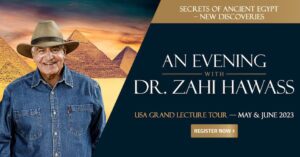
Don’t miss out on this unforgettable evening as Dr. Hawass reveals the most closely guarded secrets of ancient Egypt and presents his groundbreaking new discoveries and latest research live on stage. As the man behind all major discoveries in Egypt over the last few decades and director of several ongoing archaeological projects, Dr. Hawass may yet surprise you with unexpected revelations that will make news across the world.
_____________________________





